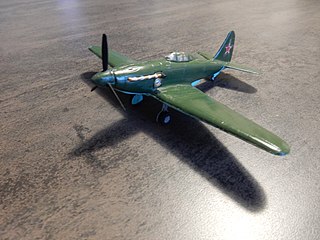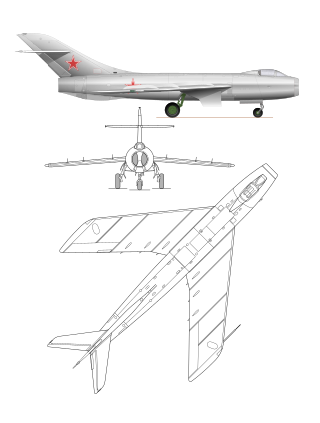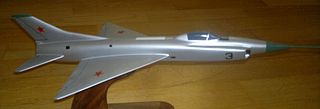
The Sukhoi Su-2 was a Soviet reconnaissance and light bomber aircraft used in the early stages of World War II. It was the first airplane designed by Pavel Sukhoi. The basic design received an engine and armament upgrade (Su-4) and was modified for the ground-attack role (ShB).

The Lavochkin La-5 was a Soviet fighter aircraft of World War II. It was a development and refinement of the LaGG-3, replacing the earlier model's inline engine with the much more powerful Shvetsov ASh-82 radial engine. During its time in service, it was one of the Soviet Air Force's most capable types of warplane, able to fight German designs on an equal footing.

The Tupolev Tu-2 was a twin-engined Soviet high-speed daylight and frontline bomber aircraft used during World War II. The Tu-2 was tailored to meet a requirement for a high-speed bomber or dive-bomber, with a large internal bomb load and speed similar to that of a single-seat fighter. Designed to challenge the German Junkers Ju 88, the Tu-2 proved comparable and was produced in torpedo, interceptor and reconnaissance versions. The Tu-2 was an effective combat aircraft and it played a key role in the final offensives of the Red Army.

The Lavochkin La-9 was a Soviet fighter aircraft produced shortly after World War II. It was one of the last piston engined fighters to be produced before the widespread adoption of the jet engine.

The Yakovlev Yak-16 was a Soviet light transport that first flew in 1947. Prototypes were built in both passenger and military cargo versions, but neither was put into production as the Antonov An-2 was felt to be more versatile.

The Shvetsov ASh-82 (M-82) is a Soviet 14-cylinder, two-row, air-cooled radial aircraft engine developed from the Shvetsov M-62. The M-62 was the result of development of the M-25, which was a licensed version of the Wright R-1820 Cyclone.

The Beriev Be-6 was a flying boat produced by the Soviet Beriev OKB. It was capable of accomplishing a wide variety of missions, such as long-range maritime reconnaissance, coastal and supply line patrols, torpedo/bombing strikes, mine-laying, and transport operations.
The Lavochkin La-126 was a World War II Soviet prototype piston-engined fighter aircraft.

The Sukhoi Su-6 was a Soviet ground-attack aircraft developed during World War II. The mixed-power high-altitude interceptor Su-7 was based on the single-seat Su-6 prototype.
The Sukhoi Su-10 or Izdeliye Ye was a Soviet turbojet-powered bomber aircraft built shortly after World War II.
The Sukhoi Su-8 or DDBSh was a Soviet prototype ground-attack aircraft of World War II.

The Sukhoi Su-1 or I-330 was a prototype Soviet high-altitude fighter aircraft built at the beginning of World War II. An improved version, designated Su-3 (I-360), was also built and tested the following year. Neither version was mass-produced.
The Sukhoi Su-5 or I-107 was a Soviet mixed-power prototype fighter aircraft built toward the end of World War II.

The Sukhoi Su-15 was a prototype Soviet all-weather interceptor which never reached production.

The Sukhoi Su-17 was a prototype Soviet fighter. The name was later reused for an entirely different fighter-bomber, see Sukhoi Su-17.

The Shvetsov ASh-62 is a nine-cylinder, air-cooled, radial aircraft engine produced in the Soviet Union. A version of this engine is produced in Poland as the ASz-62 and the People's Republic of China as the HS-5.
UEC-Aviadvigatel JSC is a Russian developer and builder of aircraft engines, most notably jet engines for commercial aircraft. Based at the Perm Engine Plant, its products power the Ilyushin Il-76MF, Ilyushin Il-96, Tupolev Tu-204, and Tupolev Tu-214. It also designs and builds high-efficiency gas turbine units for electric power stations and for gas pumping plants. The company has its background in the Experimental Design Bureau-19 plant, set up to manufacture aircraft engines.

The Tupolev Tu-8, OKB designation '69', was a long-range variant of the Soviet Tupolev Tu-2 medium bomber that first flew after the end of World War II. It was canceled when it proved to be unstable, structurally unsound and its generators were not strong enough to fully power its gun turrets. With the advent of jet-powered bombers, Soviet military planners decided that it simply was not worth devoting the necessary resources to fix its numerous problems.
The Bartini T-117, was a twin-engined cargo aircraft designed by Robert Ludvigovich Bartini in the USSR from 1944-1948.

The Sukhoi T-49 was a prototype Soviet fighter aircraft.















